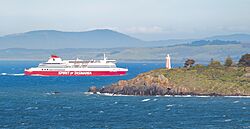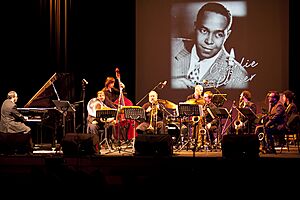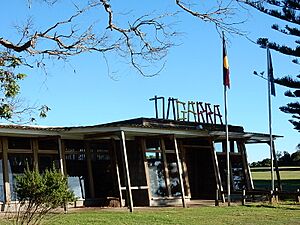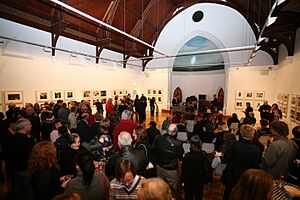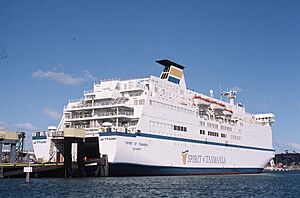Devonport, Tasmania facts for kids
Quick facts for kids DevonportTasmania |
|||||||||
|---|---|---|---|---|---|---|---|---|---|
|
From top; left to right: Devonport aerial, Rooke Street, Mersey Bluff Lighthouse, Home Hill estate, Heritage Walk Track, Spirit of Tasmania I
|
|||||||||
| Population | 26,150 (2021) (46th) | ||||||||
| Established | 1850 | ||||||||
| Postcode(s) | 7310 | ||||||||
| Elevation | 9 m (30 ft) | ||||||||
| Time zone | AEST (UTC+10) | ||||||||
| • Summer (DST) | AEDT (UTC+11) | ||||||||
| Location |
|
||||||||
| LGA(s) | City of Devonport | ||||||||
| State electorate(s) | Braddon | ||||||||
| Federal Division(s) | Braddon | ||||||||
|
|||||||||
Devonport is a busy port city on the north-west coast of Tasmania, Australia. It sits right where the Mersey River meets the sea. Devonport is about 47 kilometers east of Burnie and 98 kilometers north of Launceston.
The city's harbour is very important for Tasmania. It handles more than half of all the goods coming into and leaving the island. This makes it Tasmania's busiest freight port. Devonport also helps many industries like agriculture (farming), manufacturing (making things), and tourism (people visiting). In 2023, the City of Devonport's economy was worth about $1.5 billion.
Devonport is also home to the Spirit of Tasmania's ferry terminal. These ferries carry passengers and vehicles between mainland Australia and Tasmania. They have been running since July 1985. In 2022-23, over 450,000 passengers traveled through the Port of Devonport. A big project called Quaylink, costing $240 million, is expected to help 160,000 more passengers each year.
Devonport became a city in 1893. It was formed by joining two older towns, Torquay and Formby, which started in the 1850s. The town became a municipality in 1907. It was officially named a city by Prince Charles on April 21, 1981. Devonport is Tasmania's third-largest city. In 2021, about 26,150 people lived in the city area.
Even though it's not a huge city, Devonport has been home to many new and successful businesses. Around 1901, the Finlayson family built what is thought to be the first steam car in the southern half of the world. Also, the Holyman & Sons shipping company helped start the first airline across Bass Strait in 1934. This airline later became Australian National Airways.
Devonport is special in Australian political history. It was the hometown of Joseph Lyons, who became the tenth Prime Minister of Australia. His wife, Dame Enid Lyons, also lived here. Dame Enid made history as the first woman elected to the Australian House of Representatives and the first woman to be part of the federal cabinet. Her family home, "Home Hill," is now a popular place for tourists. It is listed with the National Trust of Australia.
Contents
- Devonport's History and Growth
- Who Lives in Devonport?
- Devonport's Weather and Environment
- How Devonport is Governed
- Suburbs of Devonport
- Arts, Culture, and Learning in Devonport
- Getting Around Devonport
- Farming in Devonport
- Schools in Devonport
- Sports in Devonport
- Famous People from Devonport
- Sister Cities
- Images for kids
- See also
Devonport's History and Growth
How Devonport Began
In the 1850s, two small towns, Formby and Torquay, grew up on opposite sides of the Mersey River. Torquay, on the east side, was bigger. It had police, a post office, hotels, and shipyards. A ferry service connected the two towns.
Between 1870 and 1880, the shipping industry grew. Workers deepened the river mouth to allow bigger ships. Soon, regular steamship services started between the Mersey River and Melbourne.
Key Milestones in Devonport
The Marine Board building, built in 1882, is the oldest building still standing in Devonport. In 1889, the Bluff lighthouse was finished. The railway also brought big changes to Formby around 1900. It combined a train station and port facilities in one place. A new wharf was built near the railway and warehouses. This led to a building boom in Formby.
In 1890, people voted to join Torquay and Formby. The two towns became one, named Devonport. The Victoria Bridge opened in 1902. This bridge connected Devonport and East Devonport by land.
Devonport was officially made a city by Prince Charles of Wales on April 21, 1981. The ceremony took place at the Devonport Oval. A ferry service that crossed the river for 160 years stopped in 2014. However, it has since started operating again.
Who Lives in Devonport?
Population and Growth
| Historical population | ||
|---|---|---|
| Year | Pop. | ±% |
| 2001 | 21,528 | — |
| 2006 | 22,315 | +3.7% |
| 2011 | 22,770 | +2.0% |
| 2016 | 23,044 | +1.2% |
| 2021 | 26,150 | +13.5% |
| 2023 | 26,997 | +3.2% |
| Source: Australian Bureau of Statistics data. | ||
In 2021, Devonport had a population of 26,150 people. By 2023, this number was estimated to be 26,977. The city council wants Devonport to grow even more. They aim for a population of 30,000 by 2030 and 35,000 by 2040.
Income and Housing
The average weekly income for households in Devonport is $1,167. This is less than the national average of $1,746. About 24.6% of households earn less than $650 per week. About 10.4% earn more than $3,000 per week.
About 34.3% of renting households and 8.1% of households with a mortgage face "housing stress." This means they spend more than 30% of their income on rent or mortgage payments.
Diversity in Devonport
Devonport has a significant First Nations population. About 7.5% of residents identify as Indigenous Australians. This is higher than the national average of 3.8%. Most residents (83.6%) were born in Australia. Other common birthplaces include England (2.9%), India (0.8%), and New Zealand (0.8%).
Most people (89.9%) speak only English at home. About 6.3% of households speak a language other than English. These include Mandarin, Nepali, and Punjabi.
In 2021, 51.1% of people in Devonport said they had no religion. About 38.7% identified as Christian. Other religions include Hinduism, Buddhism, and Islam.
Devonport's Weather and Environment
Climate in Devonport
Devonport has an oceanic climate. This means it has mild summers and cool, wet winters. From January to March, most days are mild, usually between 19°C and 24°C. There is often a lot of sunshine. Sometimes, even in summer, cool weather can arrive, and temperatures might not go above 15°C. The warmest days can reach about 28°C. Unlike eastern Tasmania, Devonport rarely gets very hot, usually staying below 30°C.
Winters are cool and cloudy, with frequent light rain. July and August are the wettest months. Because of the clouds and ocean influence, winter temperatures rarely drop below 0°C or rise above 15°C. From September to December, the weather is usually cool to mild and windy, with showers. There are also occasional warm, sunny days.
| Climate data for Devonport Airport (means and rainfall 1991–2020, extremes 1991–2022) | |||||||||||||
|---|---|---|---|---|---|---|---|---|---|---|---|---|---|
| Month | Jan | Feb | Mar | Apr | May | Jun | Jul | Aug | Sep | Oct | Nov | Dec | Year |
| Record high °C (°F) | 33.2 (91.8) |
30.6 (87.1) |
29.0 (84.2) |
24.9 (76.8) |
20.7 (69.3) |
18.8 (65.8) |
17.2 (63.0) |
18.1 (64.6) |
20.0 (68.0) |
24.8 (76.6) |
28.2 (82.8) |
30.9 (87.6) |
33.2 (91.8) |
| Mean daily maximum °C (°F) | 21.6 (70.9) |
21.8 (71.2) |
20.5 (68.9) |
17.8 (64.0) |
15.4 (59.7) |
13.5 (56.3) |
12.8 (55.0) |
13.1 (55.6) |
14.3 (57.7) |
16.0 (60.8) |
18.0 (64.4) |
19.8 (67.6) |
17.0 (62.6) |
| Mean daily minimum °C (°F) | 12.4 (54.3) |
12.7 (54.9) |
11.0 (51.8) |
8.8 (47.8) |
6.8 (44.2) |
5.1 (41.2) |
4.7 (40.5) |
4.9 (40.8) |
6.1 (43.0) |
7.4 (45.3) |
9.3 (48.7) |
10.7 (51.3) |
8.3 (46.9) |
| Record low °C (°F) | 4.0 (39.2) |
4.2 (39.6) |
1.3 (34.3) |
0.5 (32.9) |
−1.8 (28.8) |
−1.9 (28.6) |
−2.2 (28.0) |
−1.6 (29.1) |
−2.0 (28.4) |
−0.3 (31.5) |
0.6 (33.1) |
1.6 (34.9) |
−2.2 (28.0) |
| Average rainfall mm (inches) | 48.0 (1.89) |
35.3 (1.39) |
42.8 (1.69) |
56.8 (2.24) |
64.4 (2.54) |
71.8 (2.83) |
86.3 (3.40) |
81.5 (3.21) |
76.8 (3.02) |
55.2 (2.17) |
57.1 (2.25) |
47.4 (1.87) |
723.4 (28.48) |
| Average rainy days (≥ 0.2 mm) | 7.1 | 6.9 | 7.8 | 9.7 | 12.4 | 13.0 | 15.6 | 16.0 | 15.1 | 12.0 | 10.9 | 8.8 | 135.3 |
| Average afternoon relative humidity (%) | 61 | 61 | 59 | 62 | 66 | 68 | 69 | 68 | 66 | 63 | 65 | 61 | 64 |
| Mean monthly sunshine hours | 263.5 | 240.1 | 210.8 | 171.0 | 142.6 | 132.0 | 136.4 | 151.9 | 186.0 | 232.5 | 246.0 | 257.3 | 2,370.1 |
| Source 1: Bureau of Meteorology | |||||||||||||
| Source 2: Bureau of Meteorology (1981–1996 sunshine hours) | |||||||||||||
How Devonport is Governed
| Mayor of Devonport | |
|---|---|
|
Incumbent
Alison Jarman since 28 October 2022 |
|
| Style | Councillor |
| Member of | Devonport City Council |
| Formation | 1908 |
| First holder | Kerry Berwick |
Nine councillors manage the Devonport City Council. Alison Jarman became the mayor of the City of Devonport in 2022. The council looks after local services like roads, community programs, and local rules. They also support community projects, such as the Devonport Entertainment and Convention Centre.
For state-level government, Devonport is part of the Tasmanian House of Assembly’s area called Braddon. This area has members from both the Labor and Liberal parties.
For national government, Devonport is in the federal area of Braddon. This area is currently represented by Gavin Pearce from the Liberal Party of Australia. Braddon is often a close contest between the Labor and Liberal parties in federal elections.
Suburbs of Devonport
Some areas within the main suburb of Devonport include Highfield. Areas within East Devonport include Pardoe Downs, Rannoch, and Panorama Heights.
For a full list of suburbs in the City of Devonport, you can see: List of suburbs.
Arts, Culture, and Learning in Devonport
Paranaple Arts Centre
The Paranaple Arts Centre opened in November 2018. It is a modern place for art and cultural events. It houses the Devonport Regional Gallery, the Town Hall Theatre, and the Devonport Visitor Information Centre. The centre hosts live shows like music concerts, plays, and dance performances. It also has spaces for galleries, studios, and rehearsals.
Devonport Regional Gallery
The Devonport Regional Gallery started from a small gallery called The Little Gallery in 1966. It was founded by Jean Thomas. The gallery now has a yearly program of exhibitions, education, and public events. You can also find local artisan works at the North West Regional Craft Centre.
Tiagarra Aboriginal Culture Centre and Museum
The Tiagarra Aboriginal Culture Centre and Museum shows petroglyphs (designs carved in rock). It also has exhibits about the traditional life of Tasmanian Aboriginal people. "Tiagarra" means "to keep." It is one of Australia's oldest Aboriginal-run museums. It opened on October 16, 1976.
Bass Strait Maritime Centre
The Bass Strait Maritime Centre is in the old Harbour Master's House. It tells stories of Bass Strait and Devonport through objects, models, and photos. Dame Enid Lyons helped start an exhibition in 1970. This led to the Tasmanian Maritime and Folk Museum opening in 1973. The museum moved to the Harbour Master’s house in 1980. In 1999, it joined with the Devon Historical Society. In 2010, the Devonport City Council took over. The centre has 4500 objects and many photos. It explores Devonport's history from the 1800s to today.
Don River Railway
The Don River Railway is a vintage railway and museum run by volunteers. It is located in Don, a suburb of Devonport. Visitors can enjoy a train ride from Don to Coles Beach.
Health and Military Facilities
The Mersey Community Hospital in Latrobe serves the health needs of the Devonport community. Kokoda Barracks is an army base located in Devonport.
Getting Around Devonport
Devonport has many ways to get around. These include roads, intercity bus services, local public transport bus services, freight rail, passenger ferry services, air travel, and paths for cycling and walking.
Devonport Airport
Devonport Airport is about 7 kilometers east of the city. It is a key transport hub and Tasmania's third-largest airline hub. Qantas and Rex Airlines offer six daily passenger flights. QantasLink has four flights to Melbourne using turboprop planes.
The airport covers 308 hectares. It has a main runway that is 1838 meters long. There is also a smaller grass runway. The airport has taxiways, passenger terminals, and hangars for planes. Recent upgrades in 2020 improved the departure lounge and security. The airport offers fuel, car parking, and rental cars. Buses connect the airport to Devonport, but services are limited on weekends.
Transporting Goods
Three shipping companies, Strait Link, SeaRoad Shipping, and Spirit of Tasmania, offer overnight freight services across Bass Strait to Victoria.
Cement Australia has been shipping cement from Railton to Melbourne since 1926. Other goods shipped out include tallow. Goods brought into Devonport include petroleum, fuel, fertilizer, and caustic soda.
The $240 million Quaylink project will be finished by 2027. This project will add new berths and terminal facilities. It is expected to increase the port's freight operations by 40%.
Railways in Devonport

TasRail has a freight rail line that connects the port area to Burnie and Railton. Devonport used to have a railway roundhouse and maintenance rail yards along the Mersey River. This area is now a park for people to enjoy.
The Don River Railway in Don is a volunteer-run heritage railway and museum. It offers passenger train rides from Don to Coles Beach. The railway follows an old section of the Melrose line.
Passenger Ferries
Devonport is where the Spirit of Tasmania ferries depart. The Spirit of Tasmania I and Spirit of Tasmania II travel from Devonport to Geelong, Victoria. The trip takes about 11 hours. These ferries are very important for moving passengers, vehicles, and goods between Tasmania and mainland Australia.
A local ferry service called The Spirit of Devonport used to cross the Mersey River. It stopped operating in 2022 after more than 160 years.
Devonport Passenger Ferry History
| Vessel | Destination | Years | Shipping Company |
|---|---|---|---|
| Oonah | Melbourne | 1921–1935 | Tasmanian Steamers |
| Loongana | Melbourne | 1921–1935 | Tasmanian Steamers |
| Nairana | Melbourne | 1921–1948 | Tasmanian Steamers |
| Taroona | Melbourne | 1935–1959 | Tasmanian Steamers |
| Princess of Tasmania | Melbourne | 1959–1972 | Australian National Line |
| Empress of Australia | Melbourne | 1972–1986 | Australian National Line |
| Abel Tasman | Melbourne | 1986–1993 | Spirit of Tasmania |
| Spirit of Tasmania | Melbourne | 1993–2002 | Spirit of Tasmania |
| Spirit of Tasmania I | Melbourne | 2002–2022 | Spirit of Tasmania |
| Spirit of Tasmania II | Melbourne | 2002–2022 | Spirit of Tasmania |
| Spirit of Tasmania III | Sydney | 2003–2006 | Spirit of Tasmania |
| Spirit of Tasmania I | Geelong | 2022– | Spirit of Tasmania |
| Spirit of Tasmania II | Geelong | 2022– | Spirit of Tasmania |
Farming in Devonport
Devonport has a strong history in agriculture (farming). Even though the area is not huge, Devonport has been very important for growing vegetables in Tasmania. It produces a lot of beans, onions, peas, and potatoes. After World War II, factories were built to process these vegetables, especially peas. These factories helped with canning, freezing, and drying food. This was very important for local food supply and for Tasmania's overall food production.
Today, Devonport is a major contributor to Australia's farming. It also has a big dairy industry, and grows cereals, poppyseed oil and pyrethrum.
Schools in Devonport
Primary Schools
- Hillcrest Primary School
- Devonport Primary School
- Miandetta Primary School
- East Devonport Primary School
- Nixon Street Primary School
- Spreyton Primary School
- Devonport Christian School
- Our Lady of Lourdes Catholic Primary School
Secondary Schools (Years 7-12)
- Devonport High School
- Reece High School
- St Brendan-Shaw College
Senior Secondary Education (Years 11–12)
- Don College
- St Brendan-Shaw College
A TasTAFE campus, which is a training center for adults, is located in Valley Road.
Sports in Devonport
Devonport has a strong love for sports. The Devonport Football Club (Magpies) plays in the North West Football League (NWFL). They won the Senior Premierships in 2021 and 2022. The East Devonport Football Club (Swans) also plays in the NWFL.
The Devonport Rugby Club competes in the Tasmanian Rugby Union Statewide League. Touch football is played at Meercroft Park.
In soccer, Devonport City Football Club plays in the National Premier Leagues Tasmania. They also have a reserve team.
The Devonport Cricket Club plays in the North Western Tasmanian Cricket Association. Devonport’s hockey teams compete in the Hockey Tasmania leagues.
The Devonport Warriors are the biggest basketball club in the North West Basketball Union. They have over 750 members. They even played in the National Basketball League from 1983-1984. Netball is played at Devonport Netball in Spreyton.
Devonport hosts a part of the Tasmanian Cycling Christmas Carnival Series. This event also includes athletics and woodchopping.
The Devonport Golf Club has hosted big events like the Tasmanian Open. The annual Devonport Regatta features powerboat racing. The Devonport Cup, held in January, is a major horse racing event. The city also has regular harness and greyhound racing.
The Splash Devonport Aquatic and Leisure Centre has a gym and an indoor pool. The Devonport Tennis Club and East Devonport Tennis Club play in the Tennis North West Association. The annual Devonport Triathlon in February is an important championship event.
Famous People from Devonport
Artists
- Monique Brumby, singer-songwriter and producer
- Phil Manning, blues guitarist and singer
- Tamara McKinley, author
- Syd Nicholls (1896–1977), cartoonist who created Fatty Finn
- Gerard Vaughan, art historian and curator
Other Notable Residents
- Max Bound (1924–2012), trade unionist and environmental activist
- Tim Lane, sports broadcaster and journalist
Politicians
- Mike Gaffney, Independent member of the Tasmanian Legislative Council
- Jacqui Lambie, Senator for Tasmania
- Dame Enid Lyons (1897–1981), first woman elected to the Australian House of Representatives and first woman in the federal cabinet
- Joseph Lyons (1879–1939), 10th Prime Minister of Australia (1932–1939) and 26th Premier of Tasmania (1923–1928)
- Steve Martin, Senator for Tasmania (2018–2019)
- Hector McFie (1898–1982), Independent member for Mersey (1954–1972)
- Max Poulter (1913–1962), educator and politician, Senator for Queensland (1961)
- Jeremy Rockliff, 47th Premier of Tasmania
Sportspeople
- John Bowe, V8 Supercar driver
- Nita Burke, Australia women's national basketball team player
- Corey Cadby, darts player
- Marty Clarke, professional basketball player and coach
- David Foster, woodchopper
- Owen Kelly, NASCAR and V8 Supercar driver
- Jim Nevin, cyclist who competed in the 1952 and 1956 Summer Olympics
- David Parsons, V8 Supercar driver
VFL/AFL Players
- Darrel Baldock (1938–2011)
- Grant Birchall
- Matthew Febey
- Steven Febey
- Ben Harrison
- Brady Rawlings
- Jade Rawlings
- Matthew Richardson
- Dion Scott
- Graham Wright
Sister Cities
Devonport has a special agreement with Minamata City in Japan. This agreement, made in 1996, means the two cities are "sister cities." They share similar features and size.
 Minamata, Japan (since 1996)
Minamata, Japan (since 1996) City of Port Phillip, Victoria, Australia (This was the previous destination for "Spirit of Tasmania" ferries. The current destination is Geelong since 2022).
City of Port Phillip, Victoria, Australia (This was the previous destination for "Spirit of Tasmania" ferries. The current destination is Geelong since 2022).
Images for kids
See also
 In Spanish: Devonport (Tasmania) para niños
In Spanish: Devonport (Tasmania) para niños







